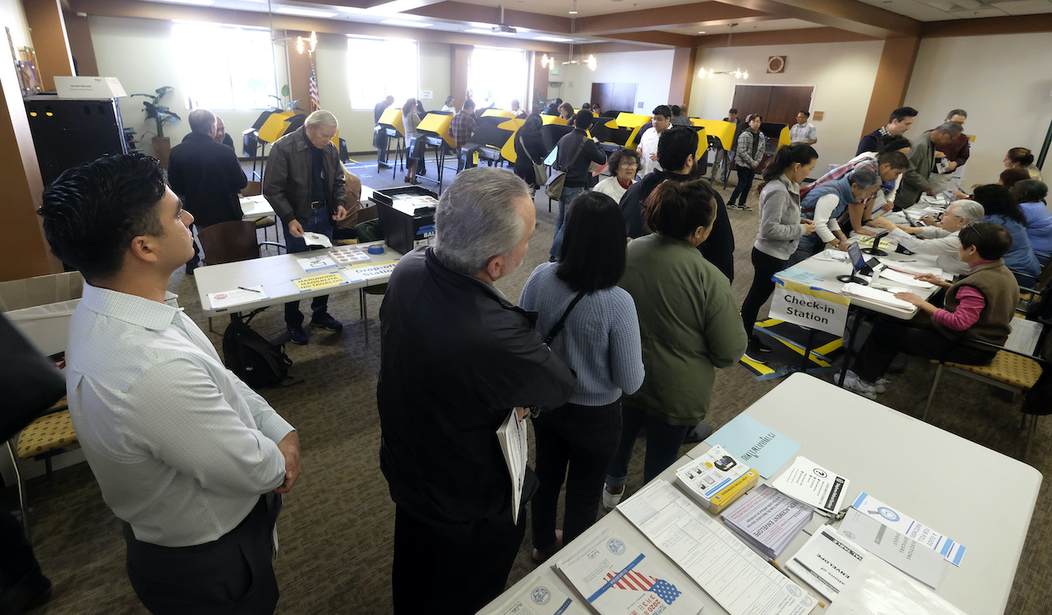The story was all over social media this weekend: Crazy California Democrats have come up with another way to cheat on elections, this time by allowing every voter to vote from the “comfort of their own home” by using a “print from home ballot system.”
According to screenshots posted to Twitter, one from the California Secretary of State’s website and one from the Orange County Registrar of Voters, all California voters (not just those with disabilities or serving overseas in the military) can request a “Remote Access Vote by Mail” ballot for the California recall election, a ballot which is printed at home and then mailed or hand-delivered to the county elections official.
HEADS UP! California’s print from home ballot system better be closely monitored during the up coming recall election. pic.twitter.com/hL4ManaRf2
— Election Wizard (@ElectionWiz) August 7, 2021
What? A universal print-at-home ballot for the California gubernatorial recall election? Say it isn’t so. Mailing every (alleged) registered voter a ballot led to disastrous results in the November 2020 election and additionally allowing every (alleged) registered voter a way to download and print a ballot will only make the cluster***k even bigger.
So is this really happening?
The short answer is yes, due to a gut-and-amend bill hastily passed by the Democrat supermajority in June 2020. This legislative workaround was necessary because Newsom had had his Executive Order-loving wings clipped by a Sutter County Superior Court judge last fall after a lawsuit challenging those orders was brought by two Republican Assemblymembers: Kevin Kiley and James Gallagher.
Still, there are some questions for which answers weren’t easily found online. RedState has sent those questions to the California Secretary of State’s office and three county elections offices, and we’re consulting with Election Integrity Project-California on the issue. When the county officials respond an update will be posted.
Here’s what we know right now – along with some helpful background information about how we got here. Buckle up; it’s a bumpy ride.
In 2020, California’s Elections Code didn’t allow every county to just send a mail ballot to every voter without that voter requesting a mail ballot ahead of time. But due to Executive Orders issued by Newsom in June 2020 setting aside certain sections of the state’s Elections Code every (alleged) registered voter in the state was sent a vote by mail ballot. The state legislature met during the summer of 2020 but failed to pass legislation making the changes Newsom wanted as to how the general election would be administered in light of the Wuhan coronavirus pandemic – but it’s likely that they believed no one would challenge Newsom’s Executive Orders and therefore no actual legislation was necessary.
Unfortunately for Gavin Newsom and the state’s Democrats, two legislators challenged that Executive Order – and won. Asm. James Gallagher and Asm. Kevin Kiley (who’s now running for Newsom’s seat) filed suit, represented themselves, and won. Did I mention that they won?
In the ruling, issued just days before the November 2020 election, the judge found that Newsom’s actions were unconstitutional because the California Emergency Services Act was didn’t grant the governor the power to “amend statutory law or make new statutory law, which is exclusively a legislative function.” In addition, the judge found it necessary to issue a permanent injunction against Newsom to keep him from doing so in the future:
Gavin Newsom, in his official capacity as Governor of the State of California is enjoined and prohibited from exercising any power under the California Emergency Services Act…which amends, alters, or changes existing statutory law or makes new statutory law or legislative policy.
Since people had been voting for weeks before the judge’s ruling she declared that it did not apply to the November 2020 general election, but the fact that she issued a permanent injunction against Newsom meant that she wanted to ensure that he could not pull such shenanigans in the future. Given that the Newsom recall petition was already widely circulating at that time, she was fully aware that he could possibly face a recall election in the year following her ruling and seemingly wanted to make it crystal clear that Newsom did not have the authority to issue Executive Orders in that election under the California Emergency Services Act.
However, the legislature would be allowed to change election law, since creating/amending law is their job. Did they do that?
We’ll start at the California Secretary of State’s website referenced in the Election Wizard tweet. The Remote Access Vote by Mail (RAVBM) page still makes reference only to the November 4, 2020, general election. But, the California Gubernatorial Recall Election page contains a link to a document titled “California Gubernatorial Recall Election Administration Guidance” under “County Elections Officials Resources.” In that document there’s just one sentence in the RAVBM section:
All county elections officials shall permit any voter to cast a ballot using a certified RAVBM system, regardless of whether the voter is a voter with disabilities or a military or overseas voter. (Elec. Code, § 1605(c).)
Since the entry referred to Section 1605(c) of the California Elections Code, I looked that up next. It reads:
(c) The elections official shall permit any voter to cast a ballot using a certified remote accessible vote by mail system, regardless of whether the voter is a voter with disabilities or a military or overseas voter.
That section is part of Chapter 7 of the Elections Code – the entirety of which was added in 2021 when Senate Bill 152 was passed by the legislature then signed by Gov. Gavin Newsom. Since these laws were enacted through the legislative process and not by the unconstitutional use of an Executive Order, they’re not subject to the Sutter County judge’s injunction.
That is by design.
Senate Bill 152 was a blank budget bill when it was introduced on January 28, 2021. On June 14, 2021, after the Democrats knew that the recall was going to qualify for the ballot, the bill was amended to provide the California Secretary of State $35 million to conduct the recall election. As of March 2021, two California legislators estimated that the recall election would cost $81 to $100 million. So why the $35 million amount? The California legislature isn’t usually quite so tight-fisted.
As it turns out, that’s the exact amount the California Secretary of State’s office owed Biden-linked firm SKDKnickerbocker for “voter education” efforts in the 2020 election, invoices for which the California State Controller’s office told the agency there was no authorization to pay under CARES Act funds. That has to be just a coincidence, right?
Throughout June there was increasing chatter that an earlier recall election date would favor Newsom, since his poll numbers were still good and it seemed that California would come roaring back after the indoor mask mandate was lifted June 15. But a few years ago California legislators had changed the recall laws to put more roadblocks to an election day in place, hoping to save Democrat Sen. Josh Newman from recall. Those roadblocks were now a problem, so on June 23, the bill was amended again.
The June 23 amendment – entered the exact same day the Secretary of State certified the recall petition, meaning it had enough valid signatures to qualify for the ballot – allowed the Lt. Governor to set an earlier election date, mandated that every (alleged) registered voter receive a vote by mail ballot, set times for in-person voting centers, and expanded access to the Remote Access Vote By Mail Program to every (alleged) registered voter.
Because, apparently, having a ballot mailed to them and access to vote in person still isn’t quite enough access for these people.
Oh, and of course, these provisions are set to expire on January 1, 2022. Until the legislature inevitably decides they’re necessary for the future.
The bill passed both houses on June 28 on essentially a party-line vote, the final version having been “in print” for only five days (maximum). It was chaptered the same day. Just three days later Lt. Gov Eleni Kounalakis set the September 14 date for the recall election. Ironically, September 14 was the earliest date counties around the state said they could possibly be prepared.
In an AP article about the bill’s passage, Kiley was one of the GOP lawmakers quoted criticizing the bill:
With no legislative review, Democratic Lt. Gov. Eleni Kounalakis, a Newsom supporter, will be able to set an election date sooner. County clerks have said they need until at least Sept. 14 to be ready.
“The conclusion is inescapable that Gavin Newsom is cheating in the recall and this Legislature is his willing accomplice,” said Republican Assemblyman Kevin Kiley, who is considering running in the contest.
“It is an attempt to put a thumb on the scale, to try to obtain a partisan outcome for one side,” said GOP Assemblyman Vince Fong.
Now, there’s nothing inherently bad about the RAVBM system. It was instituted for people with handicaps who use assistive technology as a matter of course, or for military members serving abroad. In the instance of a person with a handicap, it eliminates the need to have someone else physically fill out the ballot for them, which is good from a ballot harvesting perspective (they don’t need that “helpful hand” advising them). In regular elections, only voters meeting those criteria qualify to receive a RAVBM ballot and must specifically request it from their county. The county emails the voter a link to the ballot, which they fill out using whatever assistive technology they normally use, print, and mail back using the envelope in which they received their traditional vote-by-mail ballot.
RAVBM ballots can also be returned in-person, and do not have to be in an official ballot envelope to be considered valid as long as the voter has signed the outside of the envelope. That’s where the major issue comes in for this recall election. Ostensibly, someone living in another state can sign up for a RAVBM ballot using the name of a California registered voter (whether that registered voter is alive, dead, or living in another state at this time), mark it using a certified RAVBM system, print, and mail it in.
The four systems certified for use by the California Secretary of State are:
- Five Cedars Group Alternate Format Ballot v5.2.1,
- Democracy Live Secure Select 1.2.2,
- Dominion Voting Systems Dominion ImageCast Remote 5.10A, and
- Los Angeles County Voting Solution for All People Interactive Sample Ballot 2.5
Yes, that last one would be the LA County proprietary system that had massive problems in both the primary and general elections in 2020. LA County’s elections system is overseen by Dean Logan, who has a bit of a checkered past in Washington State.
At this time we have not seen any official procedures for how RAVBM ballots received are secured or if they’re checked against other vote-by-mail ballots received or in-person ballots to ensure that the voter has only voted one time. One can imagine legions of union workers dutifully printing these ballots, with the union bosses keeping boxes of them at the ready to be delivered to LA County, San Francisco, or Oakland at 3 am if it looks like Gavin might actually lose this thing.
The California GOP and the Republican National Committee must band together and fight like hell to ensure election integrity on September 14. If they don’t, this will be coming to every state in the union under the guise of “voting safely” in 2022.
(EDITED 1:40 PM 8/9/2021 to clarify that a certified RAVBM system must be used to cast a RAVBM ballot and list those systems.)















Join the conversation as a VIP Member